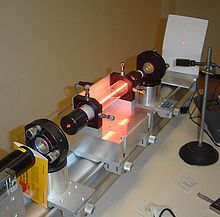- Optical table
-
An optical table is platform that is used to support systems used for optics experiments and engineering.
Contents
Explanation
In optical systems, especially those involving interferometry, the alignment of each component must be extremely accurate—precise down to a fraction of a wavelength—usually a few hundred nanometers. Even small vibrations or strain in the table on which the elements are set up might lead to complete failure of an experiment. Hence, one requires an extremely rigid table which neither moves nor flexes, even under changing loads or vibrations. The surface of the table must also be quite flat, to allow precision optical mounts to make good contact with the table without rocking and facilitate easy assembly of the optical system.
Earlier optical table tops were sometimes made of a large slab of highly polished granite. The heavy, dense material strongly suppresses the amplitude of high frequency mechanical vibrations producing a very stable surface that improves the stability of the optical system. Such tables were very heavy and expensive, however, and are not commonly available today.
Modern optical tables are typically made of top and bottom sheets of steel, aluminum, or carbon fiber, separated by a thick honeycomb lattice structure. The surface usually has a grid of threaded holes which allow the components to be bolted down to fit the optical system layout. Components may also be held to the steel surface by magnetic bases. Often, the table's legs are pneumatic vibration dampers. For even more accurate setups, one also prevents air movements and temperature gradients by enclosing the surface in a box of transparent plastic such as Plexiglas. One may also use a "flowbox", a device which produces a laminar stream of air flowing downwards, kept at constant temperature by special air conditioning.
The metal used to construct modern optical tables has a higher speed of sound than granite and therefore a higher frequency of the first eigenmode. Any vibration produced on the table below this frequency does not produce a resonant response, making the setup less sensitive to vibrations from motorized optics, cooling water pumps, etc. Vibration damping may be added to tables during their construction. As with granite's composite structure, the combination of several stiff materials with different speeds of sound produces a table for which a wide range of vibrations are critically damped. Viscous fluids are used in between the stiff materials, to aid in damping.
Hole thread and grid
There are versions using metric or imperial units.
Version Hole thread Hole grid Metric M6 25 mm Imperial ¼-20" UNC 1" (25.4mm) Breadboards
An alternative to an optical table is an optical breadboard. Some optical systems use breadboards made of solid aluminum for later integration with a larger system with some form of vibration control. Most optical breadboards are constructed from steel, aluminum, or carbon fiber sheets with honeycomb structure and can be placed on an ordinary table or workbench. Breadboards are not as good as optical tables, but weigh less and are adequate for smaller optical systems that do not require extremely high levels of mechanical stability. The low weight enables one to support these tables on soft air springs which reduce vibrations coming from the floor, although this increases vibrations due to acoustic noise.
The honeycomb structure reduces bending due to the breadboard's own weight, so it can be tilted and forces applied via the soft spring supports accelerate the table as a whole without misalignment. Breadboards can therefore be used in mobile applications, such as on airplanes. Also, one can bolt a breadboard onto an optical table, build up a module of the experiment on it, and then transfer the module as a whole onto another table without the need to realign the components on the breadboard. Similarly, custom-built optical devices are assembled and aligned on breadboards, which are then enclosed in a case and shipped to the customer.
Rails and benches
An optical bench or optical rail is a less sophisticated piece of equipment used for simple experiments, especially for classroom demonstrations. It is a long, straight, sturdy rail of steel onto which components such as light sources and lenses can be bolted down and easily shifted along the length of the rail.
External links
Categories:- Laboratory equipment
- Tables (furniture)
- Optical devices
Wikimedia Foundation. 2010.


